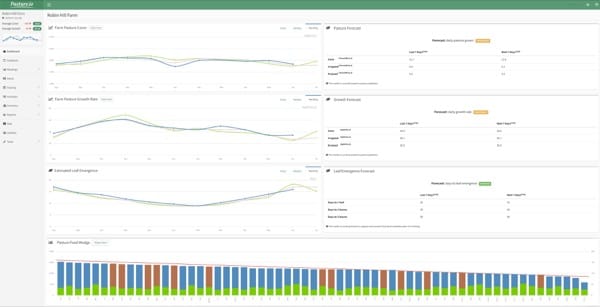Article Summary:
Autumn is the time to bring your pasture in line with your growth targets and for making preparations to meet winter. Farms across the globe choose between ryegrasses depending upon the type of pasture soil. Pasture.io has come up with productive tips for establishing ryegrass into an existing pasture.
Introduction
Heading dates serves as prime selection criteria for ryegrasses. When choosing between varieties, pick the heading date suitable to your region.
The heading date is the period from germination to the reproductive phase. Later the heading date, the longer the ryegrass will keep on providing the high-quality feed.
In this article, we will discuss how to choose among various ryegrass species to best suit the farm soil and reach growth targets. Furthermore, there are takeaway tips for productive farmers like yourself to establish ryegrass into an existing pasture. Let us begin!
Choosing Species for Tough Soil
If your pasture has light well-drained sandy soils or heavy clay soil, then growing ryegrass is not feasible. Consider growing different species.
Many farmers are growing blends of cereals, legumes, and ryegrass in water-stressed regions. Some common combinations are Oats, barely, subterranean clover, annual ryegrass, Italian ryegrass, and winter rape crops.
Autumn is the time to watch out for the pests.
1. Annual Ryegrass
Annual ryegrass usually lasts a year. It can tolerate wet feet. Annual ryegrass provides high-quality feed during late autumn and throughout the winter, up till early spring. It can be silaged and used as hay. Annual ryegrass is suited to 500mm rainfall or irrigation. Pasture.io has listed the strengths and weaknesses of annual ryegrass in this illuminating article.
2. Italian or Short term Ryegrass
Compared to Annual ryegrasses, Italian or short term ryegrass persists 1-3 years. It shows good winter growth and grazing potential before it becomes silage or hay. It is suited to areas with rainfall or irrigation of ~600mm.
3. Perennial Ryegrass
Perennial ryegrass can stay productive for up to 4 years. It has good winter growth and can be silaged. It requires ~600mm of rainfall or irrigation.
4. Perennials
There are many varieties among perennials. They can be sown in areas receiving ~500mm rainfall or irrigation. Choose a variety according to the soil type, grazing conditions, and climatic conditions in your region from among newer varieties. Learn more about the forage value of perennials here.

Types of Soil
1. Light Sandy
Sandy soils have a high proportion of sand. They are also called light soils. They have little clay. These soils drain quickly after rainfall. They are easy to work with.
Some new varieties of cocksfoot grass are showing persistence and good tillering growth in light sandy soils. They show tolerance to water stress and survive in ~400mm rainfall or irrigation. Some other varieties of cocksfoot require 600mm and 700mm rainfall or irrigation.
Cocksfoot is also tolerant to acidic soils. The seed rate varies from 5 to 10 seeds/ha.
2. Heavy cracking clay
Fescue varieties that thrive in summer can persist in dry conditions. However, they exhibit slow growth in winter. Fescue can tolerate heavy wet soils and low to moderate salinity. There are fescue varieties that can tolerate a range of rainfall conditions. Their seed rate varies from 20 to 25 kg seed/ha.
Sowing Methods
Factors like pasture density, weed density, fibrous root mat, and level of pugging determine which sowing method would suit the farm.
- Complete cultivation
- Shallow Cultivation
- Oversowing
Tips for establishing ryegrass in an existing pasture
Now that we know ryegrass is an ideal choice for its high-quality feed, nutritional value, and persistence, it is time to look at some general information while establishing ryegrass pasture.
- Removing clumpy pasture and weeds is critical. This can be done by spraying out old pasture, followed by shallow cultivation. After that, resow ryegrass of choice.
- Another way to get rid of clumps and weeds is heavy grazing followed by spraying. In this scenario, the herbicide rate is kept low. After that, resow the pasture.
- Irrigated paddocks with large amounts of summer grasses require full cultivation after the herbicide has been applied. Let the spray annihilate root material for at least 20 days.
- Apply nitrogen and phosphorus fertilizer at the sowing time to allow the seeds to quickly develop a large root system. These nutrients help ryegrass grow into a strong sward.
- Ryegrass seeding rate varies with the sowing method. For uncultivated, it is 25 kg seed/ha, while for cultivated it is more than 30 kg seed/ha.
- A shallow sowing depth of 1-2 cm is recommended for ryegrass. Use rolling to help speed up germination.
- Start grazing once the sward has established a sufficient root system to keep them planted in soil. Do the pull test to check. The plant may have a height of around 75mm.
- The Sooner you control those weeds, the better. After first grazing, see if weeds are choking the paddock. Take necessary measures.
- Apply nitrogen for strong flourishing pasture growth.
You can read more about in our Reygrass information repository.
This brings us to the end of the article. Until we meet again, Happy Pasture Renovating!
- The Dedicated Team of Pasture.io, 2022-03-31